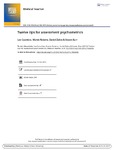Twelve tips for assessment psychometrics
| dc.contributor.author | Coombes, L | |
| dc.contributor.author | Roberts, M | |
| dc.contributor.author | Zahra, D | |
| dc.contributor.author | Burr, S | |
| dc.date.accessioned | 2016-07-01T13:54:28Z | |
| dc.date.available | 2016-07-01T13:54:28Z | |
| dc.date.issued | 2016-03-03 | |
| dc.identifier.issn | 0142-159X | |
| dc.identifier.issn | 1466-187X | |
| dc.identifier.uri | http://hdl.handle.net/10026.1/5013 | |
| dc.description.abstract |
It is incumbent on medical schools to show, both to regulatory bodies and to the public at large, that their graduating students are "fit for purpose" as tomorrow's doctors. Since students graduate by virtue of passing assessments, it is vital that schools quality assure their assessment procedures, standards, and outcomes. An important part of this quality assurance process is the appropriate use of psychometric analyses. This begins with development of an empowering, evidence-based culture in which assessment validity can be demonstrated. Preparation prior to an assessment requires the establishment of appropriate rules, test blueprinting and standard setting. When an assessment has been completed, the reporting of test results should consider reliability, assessor, demographic, and long-term analyses across multiple levels, in an integrated way to ensure the information conveyed to all stakeholders is meaningful. | |
| dc.format.extent | 250-254 | |
| dc.format.medium | Print-Electronic | |
| dc.language | en | |
| dc.language.iso | eng | |
| dc.publisher | Informa UK Limited | |
| dc.subject | Age Factors | |
| dc.subject | Curriculum | |
| dc.subject | Humans | |
| dc.subject | Psychometrics | |
| dc.subject | Quality Control | |
| dc.subject | Reproducibility of Results | |
| dc.subject | Schools, Medical | |
| dc.subject | Sex Factors | |
| dc.subject | Socioeconomic Factors | |
| dc.title | Twelve tips for assessment psychometrics | |
| dc.type | journal-article | |
| dc.type | Editorial Material | |
| plymouth.author-url | https://www.ncbi.nlm.nih.gov/pubmed/26474218 | |
| plymouth.issue | 3 | |
| plymouth.volume | 38 | |
| plymouth.publication-status | Published | |
| plymouth.journal | Medical Teacher | |
| dc.identifier.doi | 10.3109/0142159x.2015.1060306 | |
| plymouth.organisational-group | /Plymouth | |
| plymouth.organisational-group | /Plymouth/Faculty of Health | |
| plymouth.organisational-group | /Plymouth/Faculty of Health/Peninsula Medical School | |
| plymouth.organisational-group | /Plymouth/REF 2021 Researchers by UoA | |
| plymouth.organisational-group | /Plymouth/REF 2021 Researchers by UoA/UoA23 Education | |
| plymouth.organisational-group | /Plymouth/Research Groups | |
| plymouth.organisational-group | /Plymouth/Research Groups/Plymouth Institute of Health and Care Research (PIHR) | |
| plymouth.organisational-group | /Plymouth/Users by role | |
| plymouth.organisational-group | /Plymouth/Users by role/Academics | |
| dc.publisher.place | England | |
| dc.identifier.eissn | 1466-187X | |
| dc.rights.embargoperiod | No embargo | |
| rioxxterms.versionofrecord | 10.3109/0142159x.2015.1060306 | |
| rioxxterms.licenseref.uri | http://www.rioxx.net/licenses/all-rights-reserved | |
| rioxxterms.type | Journal Article/Review |


